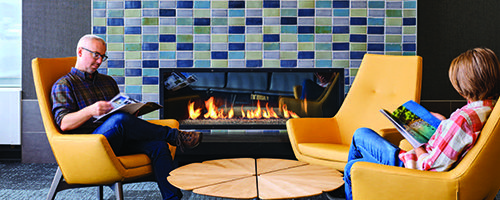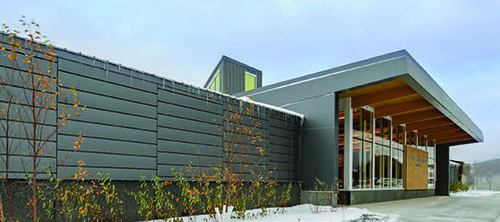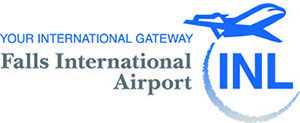After 10 years in the making, the city of International Falls, MN, recently debuted a fully rebuilt airport terminal to greet passengers travelling through the small community on the U.S./Canada border. Falls International Airport (INL) now includes a new U.S. Customs and Border Patrol area, TSA screening lane, National Weather Service office and the facility’s first jet bridge. Given the area’s cold winter weather, a large fireplace is proving to be a popular feature of the new 25,000-square-foot, single-gate terminal.
After 10 years in the making, the city of International Falls, MN, recently debuted a fully rebuilt airport terminal to greet passengers travelling through the small community on the U.S./Canada border.
Falls International Airport (INL) now includes a new U.S. Customs and Border Patrol area, TSA screening lane, National Weather Service office and the facility’s first jet bridge. Given the area’s cold winter weather, a large fireplace is proving to be a popular feature of the new 25,000-square-foot, single-gate terminal.
“We rebuilt the whole thing,” says Bob Anderson, a longtime civil servant who simultaneously serves as city mayor and chairman of the International Falls-Koochiching County Airport Commission, a joint powers board that owns and operates INL.
|
Project: New Terminal
Location: Falls Int’l Airport— Size: 25,000 sq. ft.; 1 airside gate Total Cost: $15 million Funding Partners: FAA; MN Dept. of Transportation Office of Aeronautics; state bonds; city & county Prime Consultant: SEH Inc. General Contractor: Kraus-Anderson Architectural Engineering: Alliiance Mechanical Engineering: Bartlett & Associates; ABE Associates Electrical Engineering: LHB Passenger Boarding Bridge: Ameribridge Facility Features: New U.S. Customs & Border Protection area, TSA screening lane, conference room, administrative offices, ticketing & baggage areas Design Highlights: Fireplace; Nordic accents; increased natural light; airport’s 1st boarding bridge |
Increased aircraft operations and greater security demands after the 9/11 attacks led to the absolute need for a new terminal, explains Anderson.
The process began in 2009 and wrapped up this May. SEH Inc., which has worked with the airport for more than 30 years, served as the prime consultant for the project, and Alliiance provided architecture and interior design services. In addition to addressing operational improvements, the team upgraded the facility’s dated appearance, with Alliiance offering a nod to the city’s European heritage via a design theme dubbed “Nordic Voyage, Nordic Frost.”
Bob Cohrs, SEH’s project manager, describes the result as a modern transportation space for a busy northern town. Specifically, the new terminal offers additional amenities and space for up to 100 passengers airside.
“They need air service,” notes Cohrs. “From the community standpoint, this is their gateway; and today it’s a much more comfortable and inviting experience for the travelers.”
International Intersection
Anderson explains that proximity to the Canadian border is a main attraction of International Falls. Travelers from around the world fly through INL to hunt, fish and enjoy other outdoor fun. Another economic driver for the small town is its climate, which provides the right conditions for cold weather product testing. Affectionately known as “the icebox of the nation,” International Falls has also served as a backdrop for winter-themed commercials for Cream of Wheat and DieHard batteries.
Beyond the airport, the town is home to the busiest rail port in the United States, and a large bridge that connects Canada and the U.S.

During summer, INL offers 14 commercial departures per week; in winter, the frequency drops to a dozen. In summer, the planes are often at full capacity, Anderson reports. Aircraft also refuel at INL before proceeding to destinations throughout Canada and the United States.
In order to meet the growing need of its international audience, the airport enhanced its Customs area. The new space occupies about one-quarter of the facility’s overall square footage.
Destin Nygard, project manager at Alliiance, notes that designing the TSA and Customs areas for INL required about the same involvement with regulatory agencies as projects for large airports.
“You have almost as much interaction and discussion if installing single gates or 10,” he observes. “You still need one of everything.”
Step by Step
A terminal feasibility study conducted a number of years ago by SEH Inc. revealed that the best location for INL’s new terminal was exactly where its current terminal stood. The project team subsequently split the project into two completely separate construction packages that happened to be about one year apart. During the first phase, the airport demolished part of the terminal and continued operating out of the remaining portion. Then, the second phase completed the new terminal.

“It was 18 months of challenge,” jokes Anderson. “We had to build some temporary facilities to accommodate the ground handling crew and their equipment, because we had torn down their facility to make room for the new building.”
 Marcelo Pinto, Alliiance’s lead architect for the project, notes that functionality and flexibility were key concepts in the design. For instance, the airport needed a gate big enough for chartered 737s that occasionally visit.
Marcelo Pinto, Alliiance’s lead architect for the project, notes that functionality and flexibility were key concepts in the design. For instance, the airport needed a gate big enough for chartered 737s that occasionally visit.
Cohrs says the biggest challenge of the decade-long project was securing the necessary funds. That challenge ultimately led the team to divide the project into two separate portions. Phase One addressed the public space for passengers, and the second focused on the TSA checkpoint, Customs facilities, a National Weather Service office, new conference room and administrative offices for the airport.
“The funding was always an interesting component of this project, as the whole building needed to be split into different areas that were eligible, or not, for various funding pots,” he explains.

The first ribbon cutting was held on Oct. 10, 2017, and the second on May 23 of this year.
“Those were really proud moments—to be able to open it up and show the public,” says Cohrs. “Both of them were pretty incredible and memorable.”
Anderson agrees: “We were very exuberant and satisfied that we were able to accomplish this after so many years and months of construction.”
Cohrs credits the long-term vision and dedication of the airport team for making the project possible. “The commission and Bob [Anderson} really just continued to push forward and didn’t always know where the money’s coming from, but we figured it out.”
The Cold Is No Joke
After funding, the second-biggest challenge was the weather. Scheduling construction activity was of the utmost importance, as frost doesn’t leave the ground in International Falls until May and often returns in September.
The short construction season drove the decision to use precast tilt-up panels for the terminal exterior. “We knew that we could very quickly get the shell of this building up and enclosed so they could continue to work through the winter to meet the construction schedule,” Nygard explains.
Sometimes limitations encourage people to explore other options and discover how far the envelope can be pushed, notes Pinto.
Nygard recalls steel workers battling frigid weather to get the gluam beams set. “It was 20 below, and they were up on these lifts with the wind howling,” he marvels. “It showed us how truly extreme the conditions are up there—and that was always in the back of our mind.”

Given the bitter local conditions, INL’s new passenger boarding bridge from Ameribridge is a major upgrade and welcome safety and comfort enhancement for passengers traveling during winter. Anderson considers it one of the biggest accomplishments of the entire project. “This is where weather is made,” he says with a laugh.
It’s the Little Things
April Meyer, senior interior designer with Alliiance, led the campaign to create a strong sense of place based on the area’s deep Nordic roots. The design of the carpet is based on ice crystals, and the geometric patterns throughout the facility are very Scandinavian.
 “What’s beautiful about the project is that the materials themselves aren’t really anything special,” Meyer comments. “It’s how they were used that made them more special—and that made the design affordable.”
“What’s beautiful about the project is that the materials themselves aren’t really anything special,” Meyer comments. “It’s how they were used that made them more special—and that made the design affordable.”
Natural sunlight was added with skylights and strategically placed windows. But architects were also cognizant that the area is cold for most of the year. “Despite some of the interior views, where it looks so light and bright and open, the building itself has relatively few apertures,” notes Eric Peterson, principal in charge at Alliiance. “They’re just carefully positioned to accentuate the sense of the interior, while being a very efficient building.”

These little, but thoughtful, touches have created an exciting new terminal for INL, he remarks.
 One particularly popular feature is the new fireplace, which comes into view as passengers walk into the terminal and includes a blower system that circulates heat throughout the area. “It was not extravagant in terms of cost, but created an appealing area,” explains Peterson. “Smaller airports deserve every bit of comfort and feeling of hospitality as anybody else.”
One particularly popular feature is the new fireplace, which comes into view as passengers walk into the terminal and includes a blower system that circulates heat throughout the area. “It was not extravagant in terms of cost, but created an appealing area,” explains Peterson. “Smaller airports deserve every bit of comfort and feeling of hospitality as anybody else.”

While Anderson was initially worried that the airport would be criticized for allocating money to a non-essential design element, the fireplace has been an appreciated accent. “Many passengers, and locals, have said how wonderful it is to be able to sit in the terminal with a fireplace going,” he reports.
The addition of bathrooms, drinking fountains and vending machines in the secured area of the terminal were also well received. Such amenities may sound trivial, but they increase passenger convenience, notes Anderson.
“Bob [Anderson] is a great ambassador for his city,” Nygard emphasizes. “It’s so rewarding to see people embracing and using the facility. When we were just there, we saw people from all over the world coming through with their fishing gear. INL is the gateway to the Great North.”



 facts&figures
facts&figures

